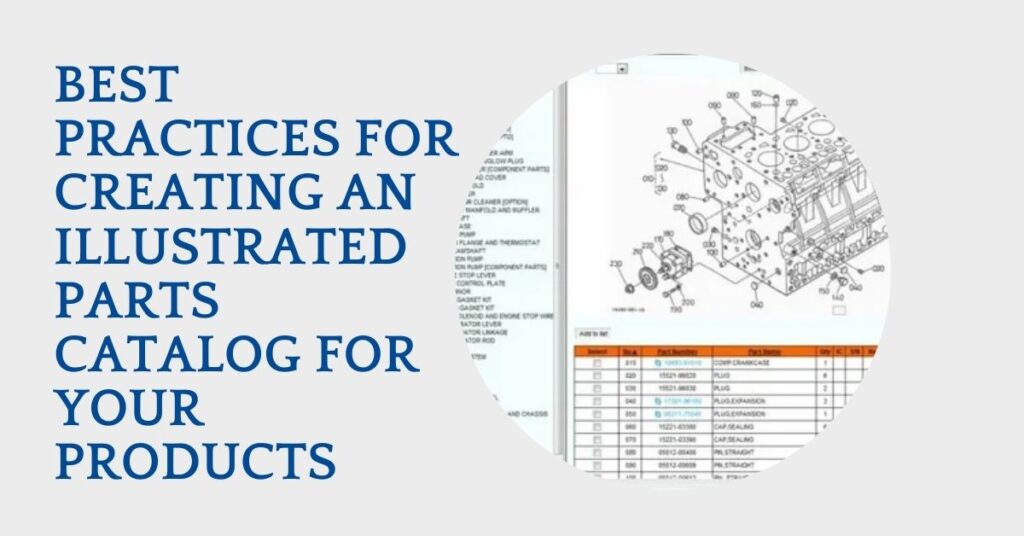Creating an illustrated parts catalog is an essential step for businesses that want to provide clear, detailed information about their products. This catalog serves as a visual guide that helps customers, technicians, and even employees identify, order, and replace parts with ease. A well-designed parts catalog can streamline inventory management, reduce errors, and improve customer satisfaction. However, creating an effective and user-friendly catalog requires more than just listing part numbers and descriptions. It requires careful planning, attention to detail, and a structured approach to ensure that the catalog serves its intended purpose.
In this blog, we’ll cover the best practices for creating an illustrated parts catalog. These tips will help ensure that your catalog is accurate, easy to use, and visually appealing.
Note -Looking to create a professional Illustrated Parts Catalog for your products? DDSPLM offers advanced solutions that help businesses design detailed, easy-to-navigate catalogs. With expert tools and support, transforming your parts catalog into a valuable resource is simpler than ever. Get in touch with DDSPLM today to streamline your parts management and enhance customer satisfaction.
1. Start with Detailed and Accurate Information
The foundation of any great illustrated parts catalog is accuracy. If the parts information is incorrect or unclear, the entire catalog will be ineffective, and customers may face difficulties when ordering or replacing parts. Therefore, the first step in creating a parts catalog is to gather detailed, accurate information about each part.
illustrated parts catalog
Key Information to Include
For each part in the catalog, you should include the following details:
- Part Number: This is the unique identifier for each part. It should be easy to find and use in your catalog, making it simple for customers to search for specific parts.
- Part Name and Description: Provide a clear, concise description of what each part does. This helps users understand the function of the part and how it fits into the larger system or product.
By collecting all this information upfront, you’ll be able to create a catalog that is accurate and valuable to users.
2. Use High-Quality Illustrations
An illustrated parts catalog should, as the name suggests, include high-quality visuals that clearly show the part in detail. Visuals help users quickly identify the part they need and understand how it fits into the larger assembly. Without proper illustrations, users may struggle to determine which part is correct, leading to mistakes and delays.
Types of Illustrations to Include
- Line Drawings or Schematics: Clear, simple line drawings or schematics are perfect for showing parts from different angles. They help users understand the relationship between the part and other components in the system.
- Photographs: High-resolution photographs of the actual parts can be especially helpful for customers who want to ensure they’re getting the correct part. Including multiple views (front, side, and back) can provide additional clarity..
When choosing illustrations, always ensure they are clear, high-quality, and well-lit. The more detailed and accurate your images, the easier it will be for users to identify the right parts.
3. Organize the Catalog for Easy Navigation
A key element of an effective parts catalog is organization. If the catalog is poorly organized, users will have a difficult time finding the parts they need, which defeats the purpose of the catalog. Proper organization helps users navigate the catalog quickly and efficiently, saving time and reducing frustration.
How to Organize Your Parts Catalog
- Categorize Parts: Group parts based on their function or the part of the product they belong to. For example, if you’re creating a catalog for a vehicle, you might organize parts into categories such as “Engine Components,” “Transmission Parts,” and “Electrical System.”
- Subcategories: Within each category, you can create subcategories to further organize parts. For example, under “Engine Components,” you might have subcategories for “Spark Plugs,” “Filters,” and “Valves.”
4. Provide Clear Instructions for Ordering
The ultimate goal of a parts catalog is to help customers identify and order the parts they need. To achieve this, you should provide clear instructions for how users can place an order for the parts in your catalog.
Ordering Instructions to Include
- Order Form: If your catalog is a physical print or PDF version, include an easy-to-follow order form with fields for the part number, quantity, and shipping details.
- Online Ordering: If your catalog is digital, make sure to provide links to online ordering platforms or e-commerce websites where users can purchase the parts directly. If applicable, include information on how users can create an account or track their orders.
- Shipping and Delivery Information: Provide clear details about shipping options, delivery times, and any associated costs. Customers will appreciate knowing how long it will take to receive their orders and what shipping methods are available.
- Return Policy: If applicable, include a section on your return or exchange policy in case customers receive incorrect parts or change their mind.
Including detailed and clear ordering instructions makes it easier for customers to place orders without confusion, leading to a smoother purchasing process and better customer satisfaction.
5. Keep the Catalog Updated
Once your parts catalog is created, it’s important to regularly update it. Products evolve over time, new parts are introduced, and older parts may be discontinued. Keeping your catalog up to date ensures that customers always have access to the most current information.
Tips for Keeping the Catalog Updated
- Track Changes: Keep a record of all new parts, discontinued parts, and updated specifications so you can easily update your catalog when needed.
- Version Control: If you have digital catalogs, consider implementing version control so users can easily identify the latest version. Each catalog update should have a clear version number and release date.
Regularly updating your catalog ensures that your customers always have access to accurate, relevant information, and it prevents confusion caused by outdated or obsolete parts.
6. Make the Catalog Accessible
Finally, it’s important to make sure your parts catalog is accessible to your customers. Whether it’s in print or digital form, the catalog should be easy to access, navigate, and use.
How to Make the Catalog Accessible
- Print Version: If you provide a physical catalog, make sure it’s easy to request or purchase. Consider offering it as a free resource or for a nominal fee. Ensure the print quality is high so the images and text are clear.
- Digital Version: If your catalog is available online, make sure it’s hosted on a user-friendly website. Optimize the catalog for mobile use so customers can access it on their phones or tablets. A downloadable PDF format is often convenient for users who want to keep a copy for future reference.
Making your catalog easy to access ensures that users can find and use the information they need whenever they need it.
Conclusion
Creating an effective illustrated parts catalog involves more than just compiling a list of components. By following these best practices, you can design a catalog that is accurate, visually clear, and easy for customers to navigate. From gathering detailed part information to organizing the catalog logically and keeping it updated, every step plays an important role in ensuring the catalog is a valuable resource.
For more insightful articles related to this topic, feel free to visit theguestblogs.com






